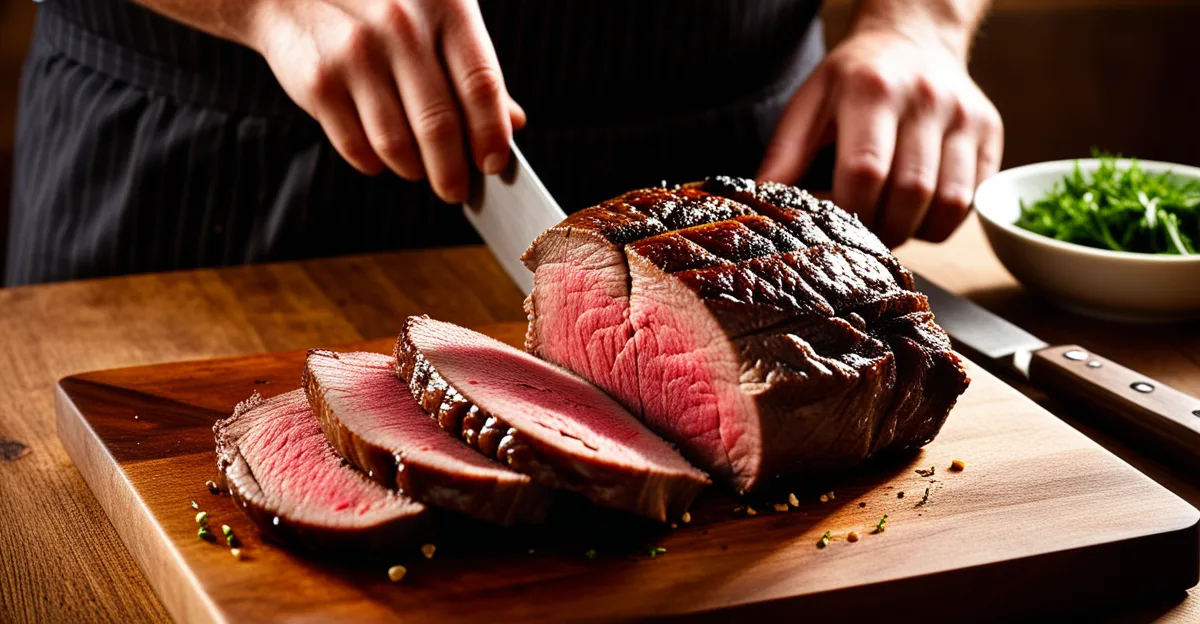Essential Techniques for Preparing a Classic Roast Beef Dinner
Mastering roast beef preparation begins with selecting the perfect cut. Cuts like ribeye, sirloin, or top round are ideal due to their balance of tenderness and flavor. Ribeye offers marbling for juiciness, while sirloin provides leaner texture without sacrificing taste.
Next, seasoning and marinating are crucial for depth of flavor. Salt and freshly ground pepper form the classic base. For enhanced richness, rubbing the beef with herbs such as rosemary and thyme, combined with garlic and olive oil, infuses aromatic notes deeply into the meat. Marinating times vary; a minimum of 1 hour allows flavors to penetrate effectively without overwhelming the natural beef taste.
Also read : How can you master the art of cooking a traditional Sunday roast?
Roasting temperature and timing are pivotal for achieving the desired doneness. Experts recommend starting at a high temperature (220°C/425°F) for 15 minutes to develop a crust, then reducing to 160°C/325°F to cook evenly. Timing depends on weight and preferred doneness—for medium-rare, aim for about 15-20 minutes per 500 grams. Use a meat thermometer to ensure precision: 55°C (130°F) for medium-rare is optimal. Following these traditional roast beef techniques ensures a juicy, flavorful result every time.
Enhancing Tenderness and Rich Flavour
Achieving truly tender roast beef hinges on several factors. First, the quality of the cut affects tenderness, but so does preparation and cooking. Allowing the beef to rest for at least 15 minutes after roasting is critical; this step lets the juices redistribute, resulting in a juicy, flavorful finish rather than dry meat.
Also to read : What are the origins and variations of the traditional ploughman’s lunch?
Flavor infusion can be significantly elevated by using herb crusts or aromatic additions like garlic and butter. Rubbing the beef with fresh rosemary, thyme, and crushed garlic before roasting enhances the natural beef taste while sealing in moisture. Basting occasionally with melted butter during cooking not only adds richness but helps develop a golden crust using traditional roast beef techniques.
Another important technique involves controlling temperature fluctuations. Cooking too fast can toughen the meat; slow and steady roasting at recommended temperatures improves tenderness. Combining these roast beef tips—resting, herb crusts, and mindful roasting—delivers an impeccable balance of tenderness and rich flavour in every bite.
Preparing Traditional Accompaniments
Enhance your classic roast beef dinner with traditional sides that perfectly complement the main dish. Authentic Yorkshire pudding is a must-have. The batter combines eggs, flour, and milk in equal parts, whisked until smooth. Key tips include using hot oil in the baking tray and preheating the oven to 220°C (425°F) to achieve a crispy exterior and a light, airy interior.
For classic roast vegetables, select hearty options like carrots, parsnips, and potatoes. Cut them evenly to ensure uniform cooking. Tossing vegetables in olive oil with herbs like rosemary and thyme before roasting at around 200°C (400°F) helps develop caramelisation, which enhances flavor depth.
A rich, homemade gravy ties the meal together beautifully. After roasting, pour off excess fat from the pan, leaving browned bits and juices. Deglaze with red wine or beef stock, then simmer with flour or cornstarch to thicken. The result offers a balanced, luscious sauce that complements both the beef and vegetables in this traditional roast beef dinner.
Expert Tips for a Perfect Roast Beef Dinner
Avoiding common errors during roast beef preparation is essential for success. Overcooking is the most frequent mistake; it dries out the meat and dulls flavor. Using a meat thermometer and following step-by-step roast beef timing prevents this. Another pitfall is neglecting to let the beef rest after roasting. Resting allows juices to redistribute, ensuring moist, tender roast beef and easier carving.
For serving, presentation matters. Carve against the grain in thin slices to maximize tenderness and showcase the beef’s texture. Rested beef slices hold shape better, creating a more appealing plate. Use a sharp carving knife and steady strokes for clean cuts.
Expert chefs recommend seasoning well in advance, allowing time for flavors to penetrate deeply during marinating. This is a crucial element of traditional roast beef techniques, enhancing taste beyond surface seasoning.
To further refine your roasting skills, consider visual guides or detailed videos. These resources provide clear demonstrations of seasoning, temperature control, and carving—key steps in mastering expert roast beef preparation. Applying these tips will elevate your roast beef dinner from good to outstanding every time.







